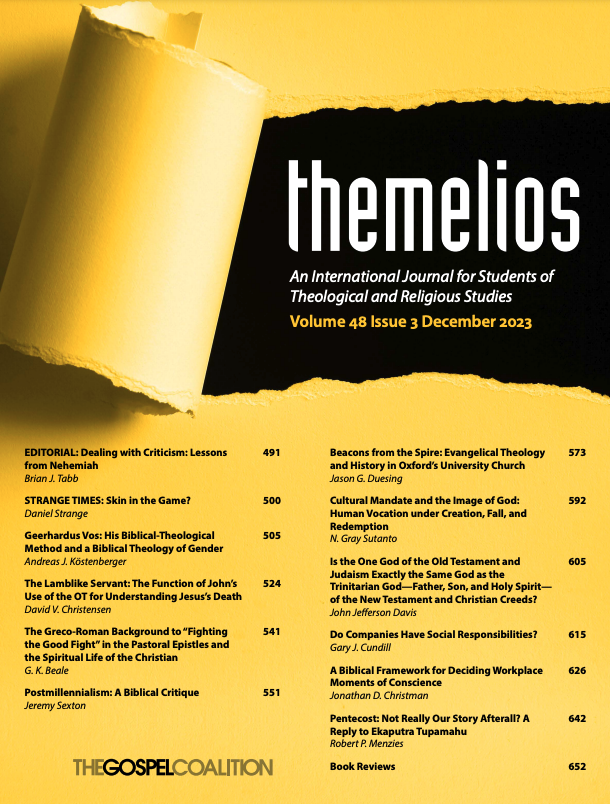
Two Books Reviewed:
The Case Against the Sexual Revolution & Feminism Against Progress
A book review from Themelios, an International Journal for Students of Theological and Religious Studies, Volume 48 Issue 3 December 2023.
Louise Perry. The Case Against the Sexual Revolution: A New Guide to Sex in the 21st Century. Cambridge: Polity Press, 2022. 200 pp.
Mary Harrington. Feminism Against Progress. Chicago: Regenery, 2023. 254 pp.
The two books under consideration in this review are symptomatic of the struggle for cultural leadership in the changing Western world. As such they are important sign posts for Christians in our engagement with the world.
It is usually the symptoms of malady that drive us to the doctor. The work of the doctor goes beyond treating the symptoms to diagnosing the disease that gave rise to the symptoms. From that diagnosis comes the doctor’s prognosis of the outcome of the disease if untreated and the prescription of medicine or surgery that could cure or arrest the disease. But if the diagnosis is wrong, then the prognosis will also be wrong and, worse still, the prescriptions may well do more damage than the disease itself
Diagnosing physical ailments requires a highly trained physician because of our physiological complexity. However, diagnosing social ailments is considerably more difficult. Society and culture are so complex that no amount of research and analysis can be definitive. The Enlightenment dream of decision making on the basis of scientifically demonstrable facts and a utilitarian maximisation of happiness has often failed to materialise, especially in the long term. (Easing symptoms in the short term is quite different to curing disease in the long term.) Moreover, as history painfully demonstrates, top-down social change usually results in some form of collateral damage.
Bottom-up social change, on the other hand, normally happens more incrementally and usually as a consequence of innumerable factors and causes. But even then, pinpointing one or even a few major components of the resulting shift is very difficult. General observations are therefore easily dismissed as failing to consider or weigh accurately some particular factor that has helped to produce social change.
Two related areas of massive social change occurred last century and the effects of both continue to be felt today: the sexual revolution of the 1960s and the feminist revolution in the 1970s. Both movements appeared to be addressing problems in Western culture with an alternative way of life that would lead to social improvement. Both were grass roots movements that have now garnered a high degree of institutional and even governmental support. Both have now been running long enough to evaluate their success.
Louise Perry’s The Case Against the Sexual Revolution and Mary Harrington’s Feminism Against Progress are attempts to weigh the result of these revolutions. Given the scope of their concerns, they both speak in broad generalisations that pedants and opponents can always challenge at the level of detail. But their arguments open up very valuable debates and their general theses have much to commend them.
Neither book is written from outside the movements they critique. Rather, they are written by women of the second generation of these revolutions, women who have been raised to accept the (supposed) goods that these social changes have promised. Both books have weighed these changes and found them wanting. They both, in different ways, argue that instead of improving the human condition, the changes wrought by these revolutions have further damaged it—especially for women.
Both books highlight the significance of the technological developments that lie behind so much of what they are seeking to evaluate, especially the advent of the contraceptive pill. The ability of women to control their fertility through the pill was, in their analysis, a significant game changer. The pill gave women the right and power to control their sexual and relational lives. It encouraged women to engage in casual sex in the same way as many men. It also separated gender from biology, removing considerations of sex difference from social policy or lifestyle decisions.
To a large extent, both books have grown out of the authors’ life experiences of motherhood. For the birth of their firstborn children not only led them to a re-evaluation of life’s purpose and the importance of biological reality but freed them from many of the lies they had inherited from the feminist and sexual revolutions.
Neither book is Christian, however, and (notwithstanding Perry’s admission that she is deeply drawn to Christianity) neither author would claim to be Christian. Likewise, although Harrington occasionally uses theological language, neither book appeals to Christian understanding to make its case. They are both utilitarian evaluations of the failure of the sexual revolution and the feminist movement. Nevertheless, they accurately recount some of the very negative consequences of the false prescriptions that flowed out of the false diagnoses—negative consequences especially suffered by women.
Part of their critique of the life they inherited is based on their criticism of the shift from Enlightenment Modernism to Deconstructed Post-Modernism. Consequently, both are advocates of the modernist worldview that, despite having spawned post-modernism, now wants to call society back to the Enlightenment. This struggle between the rationality of modernism and the a-rationality, if not irrationality, of post-modernism is a familiar feature of today’s culture wars. Perry and Harrington are on the side of the struggle that supports non-censored rational debate, scientific methodology and settled Enlightenment morality. There is a sad irony here in that many traditional feminists, having spent half a century trying to get rid of any connection between gender roles and biological sex, are now appalled by the rise of gender self-determination and in some instances have found themselves cancelled (and worse!) for insisting on the reality of sex differences.
Interestingly, both books conclude that monogamous marriage, which the authors acknowledge comes from Christianity, is by far and away the best thing for women. Neither feminism nor the sexual revolution has protected and cared for women as much as does monogamous marriage. Considering the feminist and sexual revolutions’ critique, restructuring and, in many cases, demonising of marriage, these chapters on the value of marriage may (and, indeed, have) come as a surprise to many readers.
The Bible’s teaching on the right conduct of relationships between men and women—which simultaneously reveals the goodness of our creation, the damage caused by sin, the reality of God’s judgement and our desperate need for redemption—gives us a diagnosis that makes infinitely more sense than does even the best analysis of the failed dreams of the 1960s and 70s. Still, it is refreshing that even some non-Christians can see this and books like The Case Against the Sexual Revolution and Feminism Against Progress are now documenting the great cost of false diagnosis.
Therefore, while these books will teach Christians little at one level, they will confirm what we already know to be true from Scripture. More than that, they helpfully provide us with empirical arguments that will assist those of us who have felt browbeaten into the silence of self-censorship to re-engage in public debate. They are thus useful books to share with non-Christian friends to show them that the world’s answers are manifestly failing. They are evidence that we should not weaken our opposition to either feminism or the sexual revolution but rather teach God’s standards as the right ones for the twenty-first century.
Christians should never have fallen for the false diagnoses of these revolutions. Our pre-modern diagnosis comes from the Scriptures and teaches the value of both men and women created with the relational potential for marriage and the reproductive potential to produce godly offspring. Many Christians have tried to accommodate the Bible’s teaching to the sexual revolution in the serialised polygamy of divorce and remarriage. Others have tried to adapt the Bible to a feminist reading that pathologises all power and patriarchy—forgetting that our God is the all-powerful Father from whom all fatherhood is named. Such accommodations were never right and are now seen, even by non-Christian authors like Perry and Harrington, to be failures.
The Bible’s diagnosis of our plight must not be ignored or compromised. Its prognosis of the outcome of human autonomy makes perfect sense of the state of our present society. The Bible’s prescription of repentance, forgiveness and holiness, made possible by God’s redeeming work in Jesus’s death, resurrection and ascension, and the pouring out of his Spirit, is our only hope. We must keep living it and proclaiming it.

